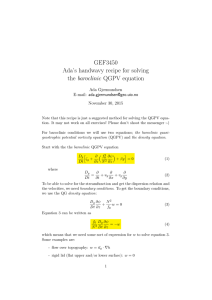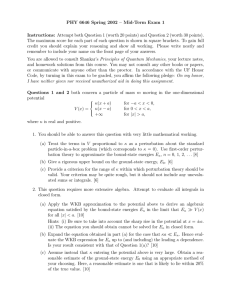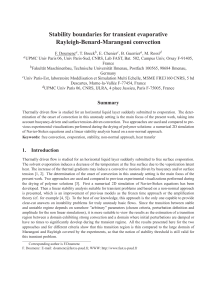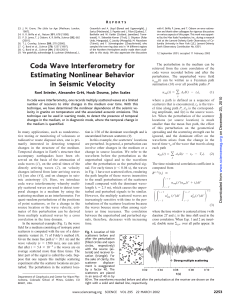GEF3450 Ada’s handwavy recipe for solving the barotropic QGPV equation Ada Gjermundsen
advertisement
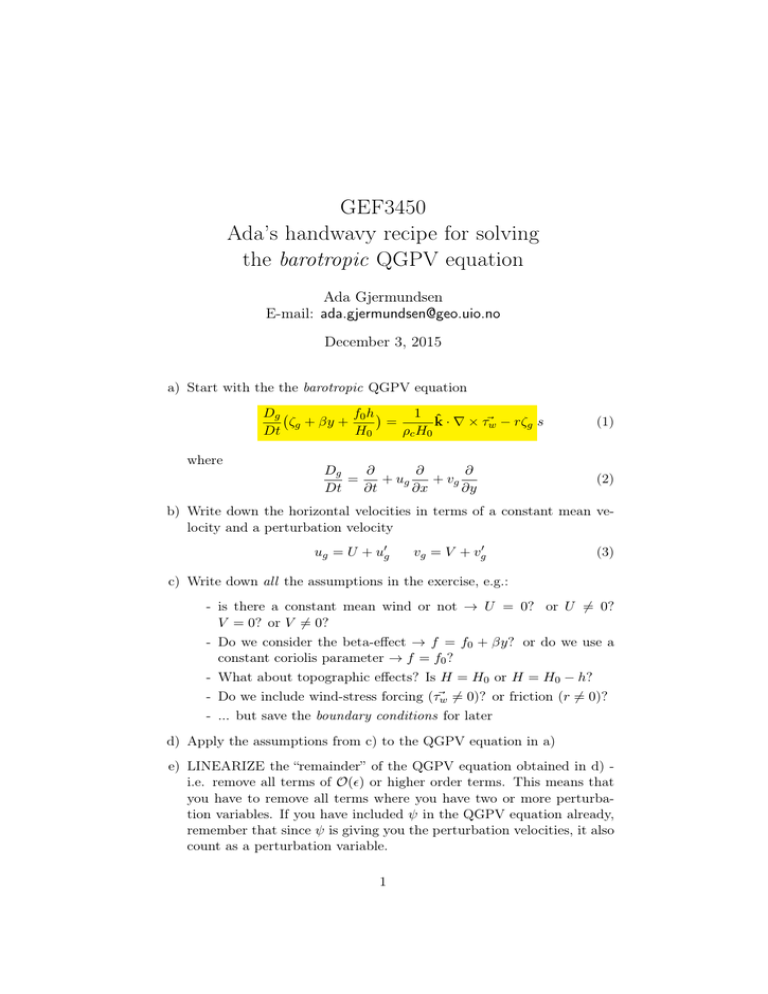
GEF3450
Ada’s handwavy recipe for solving
the barotropic QGPV equation
Ada Gjermundsen
E-mail: ada.gjermundsen@geo.uio.no
December 3, 2015
a) Start with the the barotropic QGPV equation
where
Dg
f0 h 1
ζg + βy +
=
k̂ · ∇ × τ~w − rζg s
Dt
H0
ρc H0
(1)
Dg
∂
∂
∂
=
+ ug
+ vg
Dt
∂t
∂x
∂y
(2)
b) Write down the horizontal velocities in terms of a constant mean velocity and a perturbation velocity
ug = U + u0g
vg = V + vg0
(3)
c) Write down all the assumptions in the exercise, e.g.:
- is there a constant mean wind or not → U = 0? or U 6= 0?
V = 0? or V 6= 0?
- Do we consider the beta-effect → f = f0 + βy? or do we use a
constant coriolis parameter → f = f0 ?
- What about topographic effects? Is H = H0 or H = H0 − h?
- Do we include wind-stress forcing (τ~w 6= 0)? or friction (r 6= 0)?
- ... but save the boundary conditions for later
d) Apply the assumptions from c) to the QGPV equation in a)
e) LINEARIZE the “remainder” of the QGPV equation obtained in d) i.e. remove all terms of O() or higher order terms. This means that
you have to remove all terms where you have two or more perturbation variables. If you have included ψ in the QGPV equation already,
remember that since ψ is giving you the perturbation velocities, it also
count as a perturbation variable.
1
f) Write down what’s left of the QGPV equation from e) in terms of a
streamfunction ψ
u0g = −
∂ψ
∂y
vg0 =
∂ψ
∂x
ζg0 = ∇2 ψ
(4)
Now you should have one equation (the linearized QGPV equation)
and one unknown (ψ) → BE HAPPY! (because now it is possible to
solve it!)
g) If not given in the exercise text, propose a wave solution (i.e. this is
challenging, but gets easier with some practice). Here you have to take
boundary conditions into account, if there are any.
- In most cases you can use
ψ = <{ψ̂ei(kx+ly−ωt) }
(5)
- If there are walls at y = 0 and y = L, you may use
ψ = <{ψ̂ sin(
nπy i(kx−ωt)
)e
}
L
(6)
to satisfy the no-normal flow condition.
- or if there are walls at x = 0 and x = L, you may use
ψ = <{ψ̂ sin(
nπx i(kx+ly−ωt)
)e
}
L
(7)
- If you are looking at stationary mountain waves, you may use a
solution which is wave-like in all directions
ψ = <{ψ̂ei(kx+ly+mz) }
(8)
- ... or something different. It all depends on the boundary conditions and/or the forcing/dissipation terms.
h) SOLVE! Find the dispersion relation ω and if needed, the expression
for k, l or/and m in terms of n. Remember to write down the resulting
expression for ψ and explain your result. The solution you obtain from
ψ gives you the perturbation velocities (u0g and vg0 ). If there is a mean
velocity as well, the waves will be advected by that mean wind so you
need to add the mean wind to the perturbation velocity to get the total
velocity.
2


